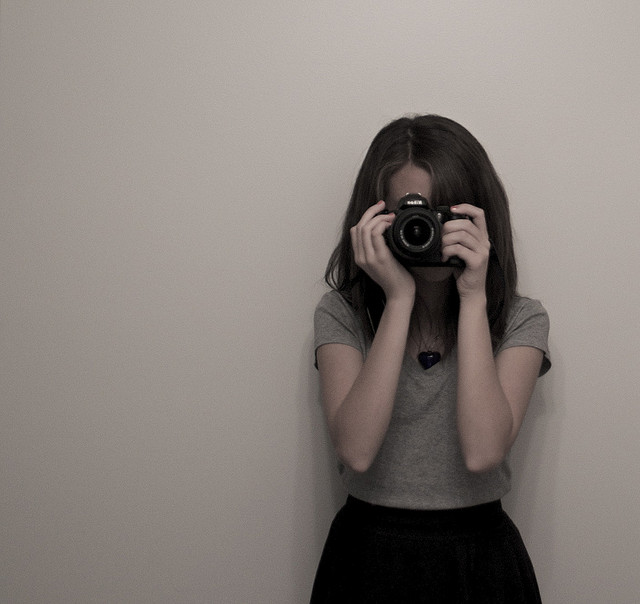“But… how can you say she was being objectified if she agreed to do the photo shoot?” my friend asked.
I’d just expressed my distaste with a nude yoga photo shoot I’d seen on the internet. It’s a good question.
The photo shoot is by prolific yoga photographer Robert Sturman, called “The Girl with the Ganesh Tattoo.” The Girl is naked on some desert rocks, interspersed with quotations about freedom—the photos didn’t make me feel free.
My friend wanted to know why it was so bad to look at erotic images. Does a feminist perspective on yoga mean we should all cover up? Isn’t that oppressive of women, too?
Yes, it definitely is and my problem isn’t her nudity. There has been a lot of buzz on in the blogosphere lately about the objectification of women in yoga media, and this is not the first piece I’ve written about it.
Still, images like these tend to get either uncritical gushing responses about beauty or mean-spirited judgments of the person being pictured.
One of the most important lessons about yoga is ahimsa (non-violence) and personal attacks and objectification are both forms of violence. My feeling is that our community is not necessarily equipped with the kinds of tools we need for critical thinking about the images we are increasingly bombarded with.
I fear we are more concerned about what goes into our morning smoothies than the kinds of images we are swallowing. Conjecturing about the feelings, intentions, and personalities of the parties involved, though, is a dead end, and generally not very neighbourly.
To answer my friend’s question, whether or not The Girl agreed to be in the shoot has nothing to do with whether or not the work is sexual objectification: we don’t know, for example, what kind of relationship this woman had with the photographer, or how much she was getting paid, or whether she was gushy or outraged when she saw the final product.
Similarly, the photographer may have created something sexually objectifying without any intention to do so.
Perhaps he was simply working with techniques he knows work without considering why they work. Sexually objectifying images are a symptom of a culture that tells women they are wanted for the uses of their bodies, and that sex sells. We buy it on deep, subconscious internal levels, and we do it to ourselves.
Objectification is dangerous specifically because it is so deeply subconscious.
Philosopher Martha Nussbaum has said that objectification “includes denial of autonomy, denial of subjectivity. Not taking people’s feelings into account, but also treating them as a mere instrument.”
The object has no agency or ability, can be owned, destroyed, or damaged with no moral concern. She adds, “The Internet opens that up in a big way because it is a relatively autonomous world in which someone who portrays a woman in a certain light, can create a whole story about her that is relatively immune to any kind of correction because it goes everywhere, it lasts forever, and then it can spill back and have real effects in the real world.”
The good news is that once we understand how to objectify someone, we can conversely learn how to subjectify them. We don’t need yogis to cover up, necessarily. What we need is to subjectify them.
So what’s a subject, anyway?
In the context of a book, movie, or image, the subject is the being that acts, the main character. It’s essentially you: the one you can relate to and align with. An object is the thing acted upon.
In a grammatical sentence, the subject is the doer: “Julie got so upset she threw her laptop out the window.” Who do you feel with here? Julie (subject), or the laptop (object)? The subject position, interestingly, can switch dramatically, depending on how something is framed and described, we can quickly change what/who we are relating to: “The laptop screamed as it fell to its death off the balcony.”
Do you feel now for the laptop or the balcony?
Spike Jonze directed a fantastic commercial for Ikea that shows how easily our feelings about who is the subject can be manipulated. After watching a lamp being thrown away in exchange for a new one, the Ikea guy tells us that we probably feel bad for this lamp (and we do!), which is crazy, because lamps don’t have feelings.
More problematically, it’s remarkably easy for us to turn the other way and objectify something that really does have feelings. It’s been a political tactic to dehumanize anything (or anyone) a group in power wants to use and abuse. In an image, we feel with the subject, and look at the object.
Learning these five techniques for either objectifying or subjectifying can help us identify them in other kinds of media so that we can become as mindful and critical of our yoga media as we are of our morning smoothies.
Vancouver Burlesque dancer Lola Frost shares on her blog a photo shoot (by Rick Legal) that is erotic, feminine, nude, but also subjectifying. Read along with me: Sturman’s photo set and Rick Legal’s on Lola Frost’s blog.
1. Faces
Faces are incredibly important to humans, and we have a whole separate brain region for facial recognition. We relate quickly to something that has a face. A quick way to give subjectivity to a pet rock is to paint two dots and a curved line on it.
Objectifying technique: In Sturman’s photo set, the first thing we see is not a face but the piece of The Girl’s body with the Ganesh tattoo. We don’t see her face much.
Subjectifying technique: In many of Legal’s photo set, we see Lola’s face, looking right at us.
2. Pieces
Cutting things into pieces is also something we do with meat. The less it looks like the whole animal, the easier it is to eat. A classic hallmark of objectification is showing just a butt or boob so you don’t have a sense of its belonging to a person/subject.
Objectifying technique: At best, we are being asked to view The Girl’s tattoo, and the woman, as a piece of art. Unfortunately, neither art nor cuts of meat have feelings.
Subjectifying technique: Lola has tattoos, too, but we see them in the context of her whole body, face included. We are never asked to look just at one piece of her body.
3. Visual distance
Seeing someone through a mirror or window (like the Ikea replacement lamp) reduces their subjectivity because we are put in the position of this side of the mirror or window, while the object is on the other side. We become the voyeur.
Objectifying technique: In Sturman’s set, there’s a distinct impression that the camera is attempting to “capture” this woman without her knowing. She is looking away, she doesn’t appear to be choosing what to show us. Our subject positions are separated: She is over there, we are over here, behind the camera, which separates us.
Subjectifying technique: In Legal’s set, there is a window, too: but we are always on the same side of it as Lola. We are in the room with her.
4. Personality and Context
A telltale sign of subjectivity is if we can learn anything about the being’s subjective self. Who is this woman? What does she like or dislike? Can she speak? Make a joke? Does she think deeply about the universe?
Objectifying technique: The Girl has a name (Michelle May), but you don’t find it out until the very end of the piece. Her nakedness and the desert atmosphere lends little sense of who she is as a person. We don’t see much of her face, so it’s very hard to project any kind of personality onto her. She is a mystery.
Subjectifying technique: Legal’s photos have a dark, boudoir style to them. Lola wrote the attached blog, so we know she likes this style, but we also see her laughing, showing emotion. She appears to be in her own home, a context of her choosing, with her fridge photos, antique chairs, and a unique hairstyle that give us lots of information about what kind of person she might be.
5. Agency and ability:
One of the telltale signs of objectification according to Nussbaum, is that the object has no agency or ability. She appears powerless.
Objectifying technique: In the one shot where The Girl is looking at us, she is not in a yoga pose, but something closer to that of a playful, harmless pinup model. (For an alternative view of pinups, check out the totally incapable-looking Menups!)
Subjectifying technique: Lola looks into the camera often, and we get the feeling we have been invited into her home, a space she has agency over, and we at one point see her holding herself up by her formidable triceps. She is choosing to show us what she wants to show us. She has agency and ability.
These five telltale signs can take subjectification and objectification out of subconscious arena and into the mindful, conscious brain. Understanding how they work and how powerful they can be helps us name objectification and celebrate subjectification.
Interestingly, we see Sturman using these same subjectifying techniques in a photo set he did with the prisoners in San Quentin, a group that is often objectified and dehumanized in society. Again, it’s difficult to speak to intention.
Sex and nudity themselves are not the problem. Sex can bring us closer together, too, when it’s subjectifying. Knowing how these techniques work means we can empower ourselves to choose more often to represent women less as objects and more…well, like Ikea lamps.
Like elephant enlightened society on Facebook.
Ed: Bryonie Wise












Read 86 comments and reply